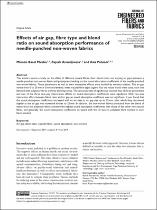 ResearchSpace
ResearchSpace
Effects of air gap, fibre type and blend ratio on sound absorption performance of needle-punched non-woven fabrics
JavaScript is disabled for your browser. Some features of this site may not work without it.
- ResearchSpace
- →
- Research Publications/Outputs
- →
- Journal Articles
- →
- View Item
| dc.contributor.author |
Mlando, Mvubu B

|
|
| dc.contributor.author |
Anandjiwala, Rajesh D

|
|
| dc.contributor.author |
Patnaik, Asis

|
|
| dc.date.accessioned | 2019-08-10T12:31:23Z | |
| dc.date.available | 2019-08-10T12:31:23Z | |
| dc.date.issued | 2019-04 | |
| dc.identifier.citation | Mvubu, M. B., Anandjiwala, R., & Patnaik, A. 2019. Effects of air gap, fibre type and blend ratio on sound absorption performance of needle-punched non-woven fabrics. Journal of Engineered Fibers and Fabrics, vol. 14: https://doi.org/10.1177/1558925019840874 | en_US |
| dc.identifier.issn | 1558-9250 | |
| dc.identifier.uri | https://journals.sagepub.com/doi/10.1177/1558925019840874 | |
| dc.identifier.uri | https://doi.org/10.1177/1558925019840874 | |
| dc.identifier.uri | http://hdl.handle.net/10204/11064 | |
| dc.description | © The Author(s) 2019 | en_US |
| dc.description.abstract | This article reports a study on the effect of different natural fibres, their blend ratios and varying air gaps between a needle-punched non-woven fabric and polystyrene backing on the sound absorption coefficients of the needle-punched non-woven fabrics. These parameters as well as their interactive effects were studied by variance analysis. The air gap varied from 0 to 25 mm in 5 mm increments; three natural fibre types (agave, flax and waste wool) were used; each one blended with polyester fibres in three blending ratios. The univariate test of significance showed that all three parameters and two of the three two-way interactions effects on sound absorption coefficients were significant. Only two-way interaction effect between blend ratio and air gap on sound absorption coefficient was not significant. It was found that the sound absorption coefficients increased with an increase in air gap size up to 15 mm, after which they decreased slightly as the air gap was increased further to 25 mm. In addition, the non-woven fabrics produced from the blend of waste wool and polyester fibres achieved the highest sound absorption coefficients than those of the other two natural fibres, and generally, the sound absorption coefficients increased with the increase in polyester fibre content in each blend studied. | en_US |
| dc.language.iso | en | en_US |
| dc.publisher | SAGE | en_US |
| dc.relation.ispartofseries | Workflow;22429 | |
| dc.subject | Air gap | en_US |
| dc.subject | Blend ratio | en_US |
| dc.subject | Natural fibres | en_US |
| dc.subject | Non-wovens | en_US |
| dc.subject | Sound absorption | en_US |
| dc.title | Effects of air gap, fibre type and blend ratio on sound absorption performance of needle-punched non-woven fabrics | en_US |
| dc.type | Article | en_US |
| dc.identifier.apacitation | Mlando, M. B., Anandjiwala, R. D., & Patnaik, A. (2019). Effects of air gap, fibre type and blend ratio on sound absorption performance of needle-punched non-woven fabrics. http://hdl.handle.net/10204/11064 | en_ZA |
| dc.identifier.chicagocitation | Mlando, Mvubu B, Rajesh D Anandjiwala, and Asis Patnaik "Effects of air gap, fibre type and blend ratio on sound absorption performance of needle-punched non-woven fabrics." (2019) http://hdl.handle.net/10204/11064 | en_ZA |
| dc.identifier.vancouvercitation | Mlando MB, Anandjiwala RD, Patnaik A. Effects of air gap, fibre type and blend ratio on sound absorption performance of needle-punched non-woven fabrics. 2019; http://hdl.handle.net/10204/11064. | en_ZA |
| dc.identifier.ris | TY - Article AU - Mlando, Mvubu B AU - Anandjiwala, Rajesh D AU - Patnaik, Asis AB - This article reports a study on the effect of different natural fibres, their blend ratios and varying air gaps between a needle-punched non-woven fabric and polystyrene backing on the sound absorption coefficients of the needle-punched non-woven fabrics. These parameters as well as their interactive effects were studied by variance analysis. The air gap varied from 0 to 25 mm in 5 mm increments; three natural fibre types (agave, flax and waste wool) were used; each one blended with polyester fibres in three blending ratios. The univariate test of significance showed that all three parameters and two of the three two-way interactions effects on sound absorption coefficients were significant. Only two-way interaction effect between blend ratio and air gap on sound absorption coefficient was not significant. It was found that the sound absorption coefficients increased with an increase in air gap size up to 15 mm, after which they decreased slightly as the air gap was increased further to 25 mm. In addition, the non-woven fabrics produced from the blend of waste wool and polyester fibres achieved the highest sound absorption coefficients than those of the other two natural fibres, and generally, the sound absorption coefficients increased with the increase in polyester fibre content in each blend studied. DA - 2019-04 DB - ResearchSpace DP - CSIR KW - Air gap KW - Blend ratio KW - Natural fibres KW - Non-wovens KW - Sound absorption LK - https://researchspace.csir.co.za PY - 2019 SM - 1558-9250 T1 - Effects of air gap, fibre type and blend ratio on sound absorption performance of needle-punched non-woven fabrics TI - Effects of air gap, fibre type and blend ratio on sound absorption performance of needle-punched non-woven fabrics UR - http://hdl.handle.net/10204/11064 ER - | en_ZA |





